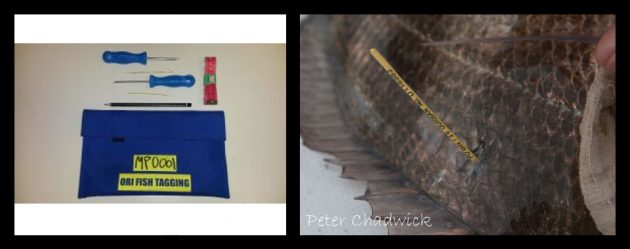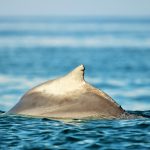The perilous state of many fish stocks worldwide is well known, as well as the data deficient status of many fish species, and the people who are have noticed a change over time, excluding the commercial fishing vessels, are the recreational and subsistence fishermen. It was recognized by Rudy van der Elst that such fishermen represent an avenue to collect much needed data on linefish species, and so in 1984 the Oceanographic Research Institute’s (ORI) Cooperative Fish-Tagging Project (CFTP) was launched. Fish tagging involves the use of a monofilament vinyl streamer attached to a plastic barb which are inserted into the dorsal musculature of a fish or shark using a sharp, hollow, stainless steel applicator. Each tag has a unique alphanumeric code which needs to be reported upon tagging along with the species, fish length (measured from the tip of the snout to the tail fork (if it has a forked tail) or to the longest point of the tail (if it has a rounded tail), date tagged, and exact location caught. While there are many other methods of tagging and tracking fish these methods can be expensive, and often require special training. Using the tags described above allows for a cheap, easily applicable method of collecting valuable data. Basically, anyone can get involved with this initiative allowing citizens passionate about fishing and conservation, with no scientific training, to tag a large number of fish at relatively low cost and thereby collect valuable ecological data. When you initially sign up to become a tagger you are sent a packet including all the materials you will need to start tagging, as well as extensive instructions on how to safely and ethically handle and tag your fish in order to minimize post-release mortality.
Since the project started in 1984 to the end of December 2016, 298 068 fish have been tagged! Of those, 12 174 were caught during 2015. These numbers represent a huge number of fish that were released to rejoin the ecosystem and hopefully breed. Plettenberg Bay falls into the Southern Cape region where 13.7% of the 12 174 fish tagged during 2015 were caught; 7.5% of the fish tagged since 1984 were tagged in the Southern Cape.
Plettenberg Bay is home to a large number of recreational fishermen, and hosts many more during season time, and we hope that if you are an angler you practice tag and release fishing, and that you encourage others to become tag-and-release fishermen. If you do catch a fish with a tag please record the tag number, species, length, date, and location, and report it to [email protected]. Recapture data can give us valuable insight into the movements, growth, and longevity of the fish species.
Written by: Minke Witteveen
For further reading:
- Dunlop, S. 2015. ORI celebrates 30 years of citizen science through its tag-and-release project. Accessed: 2016-09-10. URL: http://www.seaworld.org.za/news/entry/the-oceanographic-research-institute-celebrates-30-years-of-citizen-science/
- Dunlop, S., Mann, B., and Everett, B. 2016. Tagging News Number 29. Oceanographic Research Institute, Durban.



